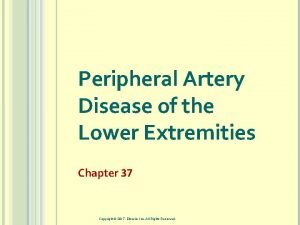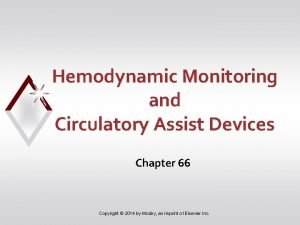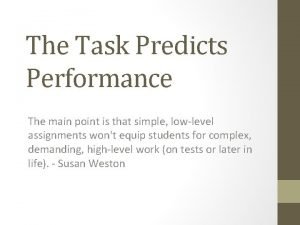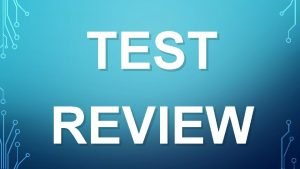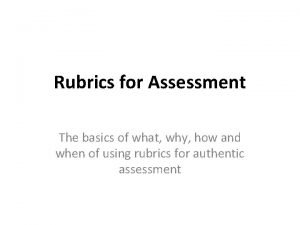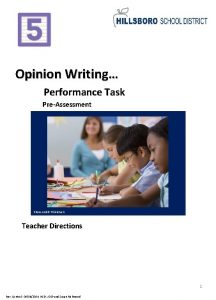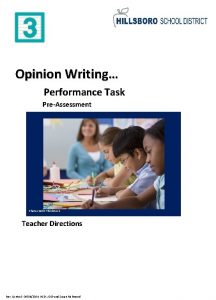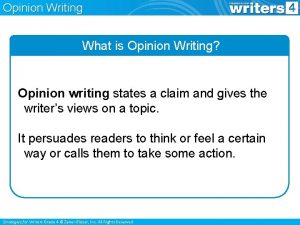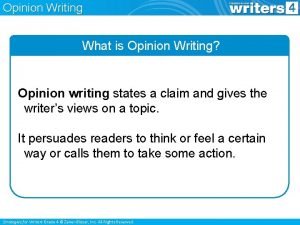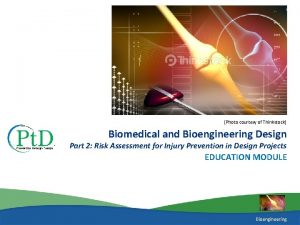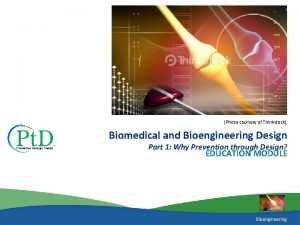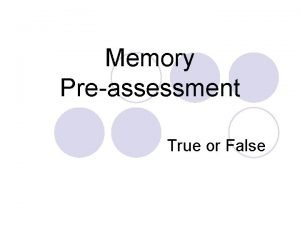Opinion Writing Performance Task PreAssessment Photo credit Thinkstock












- Slides: 12

Opinion Writing… Performance Task Pre-Assessment Photo credit: Thinkstock Teacher Directions Rev. Control: 09/06/2014 HSD – OSP and Susan Richmond

Background This is a pre-assessment to measure the task of writing an opinion piece. Full compositions or essays are always part of a Performance Task. A complete SBAC performance task would normally have: Part 1: 30 Minutes • A Classroom Activity • Reading the Passages • Taking Notes • 3 Research Questions Part 2: 35 Minutes • Writing A Full-Composition For grade 1, the teacher should read the passage aloud to the students because this assessment measures writing, not comprehension. Teachers may model note-taking for students if desired. Also in grade 1 there are only 2 un-scored research questions. DIRECTIONS This is a modified performance task. The “research questions” are not scored but provide students with information they can use to address the prompt. Provide each student with a copy of the story. Both should be read aloud while students read along silently (if they are able). The teacher should feel comfortable re-reading, explaining, or clarifying directions as needed. The story also provides information that may be used to address the prompt. The story should be read aloud at least twice before writing. If students choose to refer back to the story while writing, the teacher may provide help with reading words or phrases. Allow approximately 30 minutes for Part 1 and approximately 35 minutes for Part 2, but the prompt should not be strictly timed. Students should take the time they need to write and proofread. The writing must be done without help , but students may have access to personal dictionaries, word walls or any other resources to support spelling and mechanics that they are accustomed to using while writing. This will be first draft writing, but be sure to encourage students to proofread and correct any errors they find. 2 Rev. Control: 09/06/2014 HSD – OSP and Susan Richmond

The Best Pet Student Directions, Part 1 30 minutes Today, you are going to get ready to write an opinion piece that answers this question: Which kind of pet is best, a cat or a dog? To help you think about the question before writing: • Listen to the story carefully as I read it aloud. • Listen to the question again. Which kind of pet is best, a cat or a dog? • THINK! Decide which is the best pet. • Tell a partner which pet you chose. Then, tell your partner WHY you are picking that pet. Now you will answer two questions about dogs and cats. Use words and pictures in your answer. Student Directions, Part 2 35 minutes Now, you are going to write an opinion piece that answers this question: Which kind of pet is best, a cat or a dog? • Listen to the story again. • What pet is best for you, a cat or a dog? Why? • Write your answer. Be sure to pick either a cat or a dog and explain why this kind of pet is best. You may look back in the story for ideas. Write as much as you can. Use as much paper as you need. A good opinion piece will: 1. Introduce the topic you are writing about. 2. Clearly answer the question. 3. Give lots of reasons and explanations. 4. "Wrap up" the piece with a concluding sentence. 5. Use capitals, periods and question marks, and spell words correctly. When you are finished, check your paper over and fix any mistakes you see. If you have time, you may add a picture at the bottom or on the back to show why this pet is the best. Have fun! Rev. Control: 09/06/2014 HSD – OSP and Susan Richmond

Grade Equivalent Lexile Measure Mean Sentence Length Mean Log Word Frequency Word Count Source #1: The Best Pet My friend Ann says her pet is better than mine! I have a brown cat named Fluffy. Ann has a black and white dog named Spot. We each think our pet is the best. I told Ann that cats are better pets because they are clean, quiet and very cute. Cats wash themselves with their tongues. You don’t have to walk them. They use a litter box. Also, cats are sweet and quiet. I think dogs are too noisy! They bark a lot. They don't clean themselves or use a litter box. Dogs need someone to give them baths, train them and walk them. Dogs are more work. Ann says that cats are no fun! She says that dogs are better to play with. Spot always wags his tail when he sees her. He can even do tricks. He barks when she says, “Speak”. He knows how to roll over! Ann says dogs are also better because they protect their owners. Spot always barks when there is someone at the door. It makes Ann feel safe. So, Ann thinks dogs are best. I guess Ann’s dog is pretty cool, but so is Fluffy. Maybe different kinds of pets are good for different people. Rev. Control: 09/06/2014 HSD – OSP and Susan Richmond

Grades K - 2: Generic 4 -Point Opinion Writing Rubric NOTE: Anchor papers illustrate how descriptors for each performance level are evidenced at each grade. Working Drafts of ELA rubrics for assessing CCSS writing standards --- © (2010) Karin Hess, National Center for Assessment [khess@nciea. org] using several sources: CCSS for writing; Learning Progressions Framework for ELA (Hess, 2011); the VT analytic writing rubrics; Biggam & Itterly, Literacy Profiles; Hill, Developmental Continuum; Exemplars Young Writers rubrics; and input from NYC K-5 performance assessment pilot Assessment Development Leaders CCSS Writing Standard #1 a: Compose Opinion Pieces on Topics/ Persuasive Writing K-3 Students compose opinion pieces on topics by stating and supporting a point of view /judgment with reasons and information. Rev. Control: 09/06/2014 HSD – OSP and Susan Richmond

Opinion Writing Pre-Assessment Student and Class Scoring: Scoring Key: Total # Correct 1 = Emerging 0 -4 2 = 5 -7 3 Developing = Proficient 8 - 10 4 = Exemplary 11 - 12 School Year: 2014 -15 Grade: Teachers Name: School: Focus and Organization Student Name: Score 3 Elaboration Conventions Student ELP and Evidence Total Score 3 4 10 1. Daffy Duck and Friends 2. Mickey Mouse 4 4 4 12 3. Minnie Mouse 4 4 3 11 4. Road Runner 4 4 0 8 0 0 0 0 0 0 0 0 4 Total Students To use the Excel Version of this Score sheet. http: //sresource. homestead. com/index. html Rev. Control: 09/06/2014 HSD – OSP and Susan Richmond % Proficient % Exemplary 25% 75% 25% 50% 50%

Listening & reading Productive modalities*: Ways in which students communicate to others Speaking (e. g. , speaking, writing, and & drawing). Instruction and Writing assessment of productive modalities focus on students’ communication of their own understanding or interpretation. Interactive modalities*: Collaborative use of receptive and productive modalities as “students engage in conversations, provide and obtain information, express feelings and emotions, and exchange opinions” (Phillips, 2008, p. 3). Standard 4 Productive (S & W) An ELL can… …construct gradeappropriate oral and written claims and support them with reasoning and evidence. Listening, speaking, reading, and writing 10 - make accurate use of standard English to communicate in grade-appropriate speech and writing Receptive modalities*: Ways in which students receive communications from others (e. g. , listening, reading, viewing). Instruction and assessment of receptive modalities focus on students’ communication of their understanding of the meaning of communications from others. 9 - create clear and coherent grade-appropriate speech and text ELP 1 st Grade Band Standards Organized by Modality 1 construct meaning from oral presentations and literary and informational text through grade-appropriate listening, reading, and viewing 8 determine the meaning of words and phrases in oral presentations and literary and informational text 3 speak and write about grade-appropriate complex literary and informational texts and topics 4 construct grade-appropriate oral and written claims and support them with reasoning and evidence 7 adapt language choices to purpose, task, and audience when speaking and writing 2 participate in grade-appropriate oral and written exchanges of information, ideas, and analyses, responding to peer, audience, or reader comments and questions 5 conduct research and evaluate and communicate findings to answer questions or solve problems 6 analyze and critique the arguments of others orally and in writing By the end of an English language proficiency level, an ELL in 1 st Grade can. . . 1 2 …express an preference or opinion about a a familiar topic. 3 …express an opinion about a familiar topic or story, & give a reason for the opinion. 4 5 …express opinions about a variety of texts & topics, & give a reason for the opinion. …express an opinions about a variety of texts & topics, introducing the topic & giving a reason for the opinion, & providing a sense of closure. This performance task is based on writing. As an option if you’d like to monitor growth for ELP as a second goal, teachers can choose to assess ELP standard 4 because it aligns with this specific performance task. Your student’s full composition can be analyzed to identify English language proficiency levels. It is evident that students will be navigating through the modalities to get to the end product. However, it is important to keep in mind what the full opinion writing performance task is assessing and how deeply the student understands class content and language. The ELP growth goal is to provide the “just-right scaffolds” for students to demonstrate their understanding in order for them to move from one proficiency level to the next. Rev. Control: 09/06/2014 HSD – OSP and Susan Richmond Oregon ELP Standards Aligned with Performance Task, 2014; Arcema Tovar

Opinion Writing… Performance Task Pre-Assessment Student Name: ___________ Date: _________ Rev. Control: 09/06/2014 HSD – OSP and Susan Richmond

Grade Equivalent Lexile Measure Mean Sentence Length Mean Log Word Frequency Word Count Source #1: The Best Pet My friend Ann says her pet is better than mine! I have a brown cat named Fluffy. Ann has a black and white dog named Spot. We each think our pet is the best. I told Ann that cats are better pets because they are clean, quiet and very cute. Cats wash themselves with their tongues. You don’t have to walk them. They use a litter box. Also, cats are sweet and quiet. I think dogs are too noisy! They bark a lot. They don't clean themselves or use a litter box. Dogs need someone to give them baths, train them and walk them. Dogs are more work. Ann says that cats are no fun! She says that dogs are better to play with. Spot always wags his tail when he sees her. He can even do tricks. He barks when she says, “Speak”. He knows how to roll over! Ann says dogs are also better because they protect their owners. Spot always barks when there is someone at the door. It makes Ann feel safe. So, Ann thinks dogs are best. I guess Ann’s dog is pretty cool, but so is Fluffy. Maybe different kinds of pets are good for different people. Rev. Control: 09/06/2014 HSD – OSP and Susan Richmond

Think About It. then, answer each question. Interpret and Integrate Information Research Target 2 1. Why does the author think cats are better pets than dogs? Interpret and Integrate Information Research Target 2 2. Why does Anne think dogs are better pets than cats? 10 Rev. Control: 09/06/2014 HSD – OSP and Susan Richmond

STOP Listen as your teacher reads the directions to you for Part 2. 11 Rev. Control: 09/06/2014 HSD – OSP and Susan Richmond

Name Prompt: Which kind of pet is best, a cat or a dog? 12 Rev. Control: 09/06/2014 HSD – OSP and Susan Richmond
 Thinkstock
Thinkstock Thinkstock
Thinkstock Ngc 6822
Ngc 6822 Photo credit
Photo credit Photo credit
Photo credit Private opinion becomes public opinion when
Private opinion becomes public opinion when This can be avoided by giving credit where credit is due.
This can be avoided by giving credit where credit is due. Tiered task bias task
Tiered task bias task Performance task description
Performance task description Task predicts performance
Task predicts performance Which of the following best describes task performance?
Which of the following best describes task performance? Rubrics for performance task
Rubrics for performance task Product-oriented assessment examples
Product-oriented assessment examples
